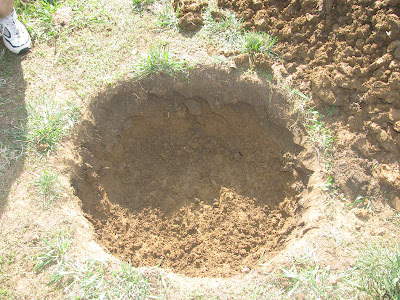Hubby Dear and I spent a lot of time out in the garden. We are finally making great strides on our homestead and it feels awesome. Namely, we have an orchard in the ground instead of just dreams of one.
 |
| Mint and Sage blossoms in the herb garden |
The first radishes of the year were ready to be eaten.
 |
| "Purple Plum" radish |
This is just a tiny percentage of the radishes we have eaten and of what is still growing in the garden.
 |
| Noodles the Silver Lakenvelder somehow made it into the garden. She's kind of a spazz. |
The occasional chicken escapee didn't harm anything.
 |
| Garden on April 29 |
 |
| Raindrops on "Sugar Sprint" Pod Pea blossoms |
 |
| We've already enjoyed salads from both the "Encore" salad mix and "Corvair" spinach |
 |
| I'm excited to report that our Swiss Chard is actually growing! It is growing slowly, but a marked improvement over last year. |
 |
| "Chester" blackberries in full bloom. |
 |
| One of our new "Heritage" raspberry canes |
We're doing our best to keep the weeds back from our new raspberry plantings. It's hard to keep up on this, but it's really important. When the new sprouts emerge and grow tall, we'll be able to mulch, but until then, we've got to do it by hand. If the weeds get ahead, they will choke out the baby raspberries. I found that out last year!
 |
| Apple trees |
Our newly planted apple trees have leafed out and look great.
 |
| "Bluecrop", "Blueray", and "Earliblue" blueberry bushes |
One of the big tasks we completed this month was to plant our blueberries. A longer post about the blueberries will be coming soon, I hope. I'm spending so much time outdoors that I don't get the computer time I used to.
We mulched and mulched and mulched everything we can get our hands on. That's another post I haven't gotten around to.
How I spent my prepping budget this month:
I know there are people who raise chickens on a budget, but I am not one of those people. I keep learning about things that would make my life easier or more convenient. Then I buy them and use up all my prepping budget. It is going to take a looooong time before we break even on all our chicken expenses.
 |
| Storage for chicken feed |
We are storing our chicken feed in metal trash cans. They are supposedly water-tight, but I found that after a heavy rain that the feed inside was damp in places. Not good! I shopped around and found this Rubbermaid storage shed
 |
| One can is for feed, the other for bags of scratch, DE, grit, etc. |
I have been fighting a losing battle trying to keep pine shavings out of the chickens' food, water, and grit. It is better now that they spend most of their days outside, but I think the money I spent on an easy maintenance feeder, waterer, and grit dispenser is worth it.
 |
| New feeder, grit dispenser, and waterer |
I also got a rake for maintaining the litter in the coop. We are using the deep litter method of manure management. All I have to do is keep adding litter and turn it occasionally to make sure it doesn't get moist or compacted in areas. Believe it or not, my coop doesn't smell at all and I'll only have to clean it out a couple times a year.
My last chicken-related prepping purchase was to make a dust bath. That's another post for the future. (Man, I am behind, aren't I?)
After all that, I didn't have much budget left. I did buy a can of freeze dried chicken and a Katadyn Hiker Water Microfilter
Gratuitous Chicken Pics
I can't have a post that summarizes April without including photos of our backyard inhabitants. The chickens have learned a lot this month. They now wait eagerly for the automatic chicken door to open in the morning. They've learned the layout of the chicken moat and most of them can figure out how to navigate back to the coop without getting lost. Most importantly, they now put themselves to bed as night falls. It was getting old crawling army-style through chicken poop to try and catch those little buggers under the coop every evening.
 |
| I love having a mixed flock. Aren't they pretty? |
 |
| Exploring the moat |
 |
| Our rooster, Doofenshmirtz |
And that's our April! What did you accomplish this month?






































